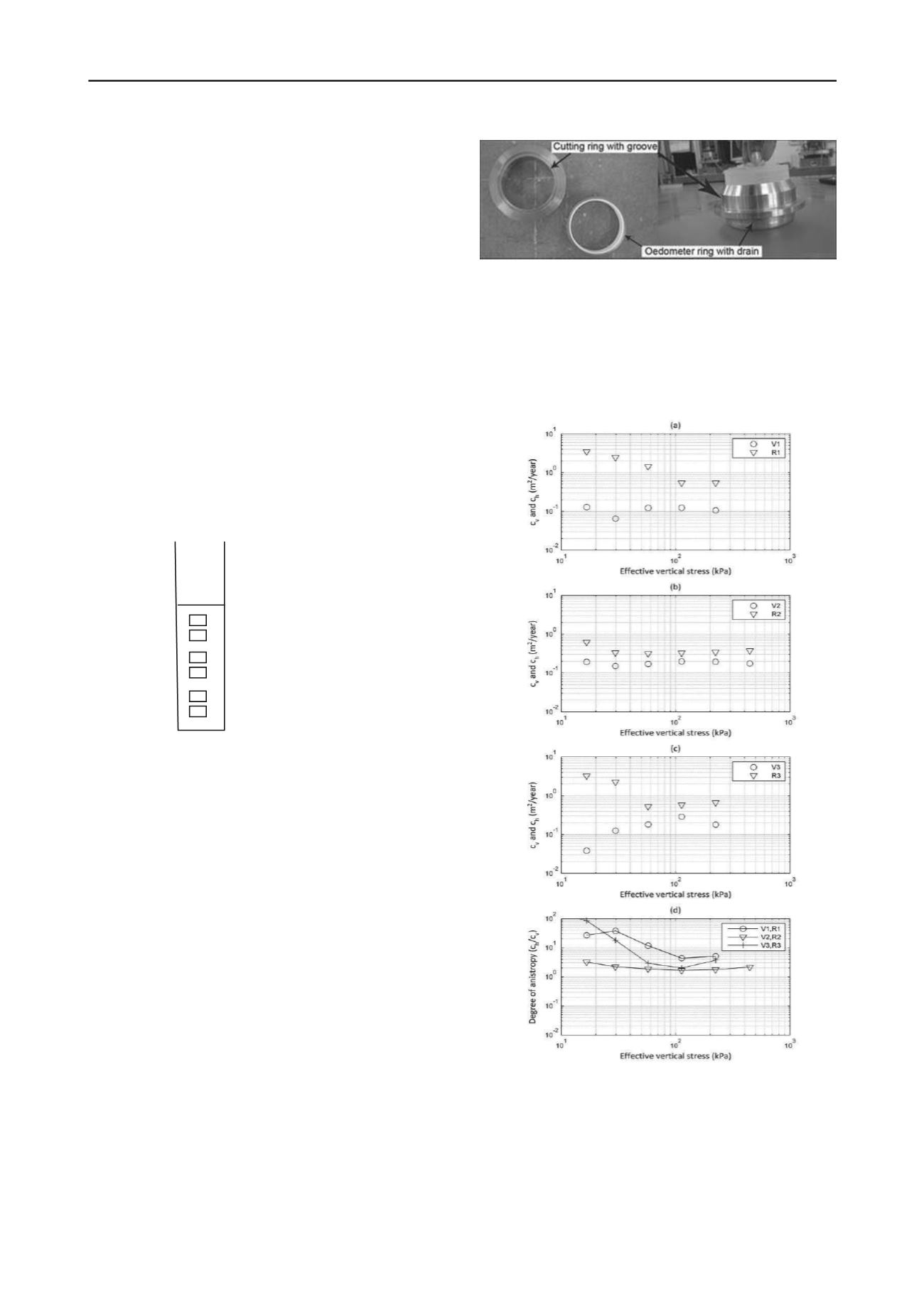
2943
Technical Committee 214 /
Comité technique 214
The mud was initially sieved through a 2.36 mm sieve to
eliminate all the broken shells and debris and then mixed with
sea water at a water content of 270 % in a slurry form. Sea
water obtained from Townsville (in Queensland) was used to
mix the slurry (Salt concentration 370 N/m
3
). The dredged mud
slurry was placed in a cylindrical tube of 100 mm diameter and
800 mm height and allowed to undergo sedimentation. When
the dredged mud column accomplished most of its self weight
consolidation settlement, it was sequentially loaded with small
weights in the range of 500 to 3000 g. The soil column was
allowed to consolidate under each vertical stress increment for
two days before the next weight was added. Pore water
dissipation was allowed through the porous caps placed at the
top and bottom of the dredged mud column. The soil column
was loaded up to a maximum vertical stress of 21 kPa over a
duration of 8 weeks. The final thickness of the column at the
completion of consolidation was around 300 mm.
From the final sediment, specimens were extruded for the
oedometer tests. Six oedometer specimens of 76 mm diameter,
20 mm height, were extruded at three different depth levels as
shown in Fig. 2. Three specimens were subjected to standard
vertical consolidation tests (denoted by ‘V’) and three were
tested to radial consolidation tests (denoted by ‘R’). The
procedure for the radial consolidation tests is explained below
briefly.
Figure 2: Specimen locations for oedometer tests
Specimens R1, R2 and R3 were tested for radial
consolidation with an outer peripheral drain. The material used
for outer peripheral drain was 1.58 mm in thickness. The strip
drain was aligned along the inner periphery of the oedometer
ring. A special cutting ring of diameter of 72.84 mm was used
to cut specimens. The cutting ring had a circular flange at its
bottom. A groove was carved along the inner periphery of the
flange, which had a thickness equal to the thickness of the
bottom edge of oedometer ring plus peripheral drain. The
oedometer ring was placed tightly in the groove, to make it
align properly with the cutting ring (Fig. 3). The specimen in
the cutting ring was then carefully transferred to the oedometer
ring using a top cap, without causing any disturbance. The
porous bottom and top caps used for standard vertical
consolidation tests were replaced with two impermeable caps,
for radial consolidation tests.
All the specimens were loaded in the oedometer apparatus
approximately between a vertical stress range of 9 kPa to 440
kPa (9 kPa, 17 kPa, 30 kPa, 59 kPa, 118 kPa and 220 kPa and
440 kPa). A load increment ratio of around 1.0 was adopted
throughout the loading stage. From the settlement – time data of
the specimens under each load increment, the vertical and radial
coefficients of consolidation
c
v
and
c
h
were estimated. Taylor’s
square root of time method was used for estimating
c
v
.
c
h
was
obtained from the curve fitting procedure given in McKinlay
(1961) for radial consolidation with a peripheral drain.
Figure 3: Specimen preparation for radial consolidation test
3.1 Results and discussion
Figs. 4(a), (b) and (c) show the comparison of
c
v
and
c
h
for pairs
V1-R1, V2-R2 and V3-R3 respectively at different effective
vertical stresses
’
v
. The degree of anisotropy, given by (
c
h
/c
v
) is
plotted against
’
v
in Fig. 4(d) for the three pairs of specimens.
R3
Notations
V3
R2
‘V’‐ Vertical consolidation
V2
‘R’‐ Radial consolidation
R1
V1
Figure 4: Comparison of
c
v
and
c
h
for specimens (a) V1, R1 (b) V2,
R2 (c) V3, R3 (d) Degree of anisotropy
As clearly observed, the horizontal coefficient of
consolidation is higher than that in the vertical direction at all
three depths. The ratio
c
h
/c
v
generally decreases with the
increase in
’
v
. At low
’
v
(
’
v
< 20 kPa), the ratio
c
h
/c
v
varies
from 2 to as much as 100. The average degree of anisotropy in
permeability (
k
h
/k
v
) for the various stress levels is given in
Table 1. The ratio
k
h
/k
v
lies between 1 to 4. The horizontal


